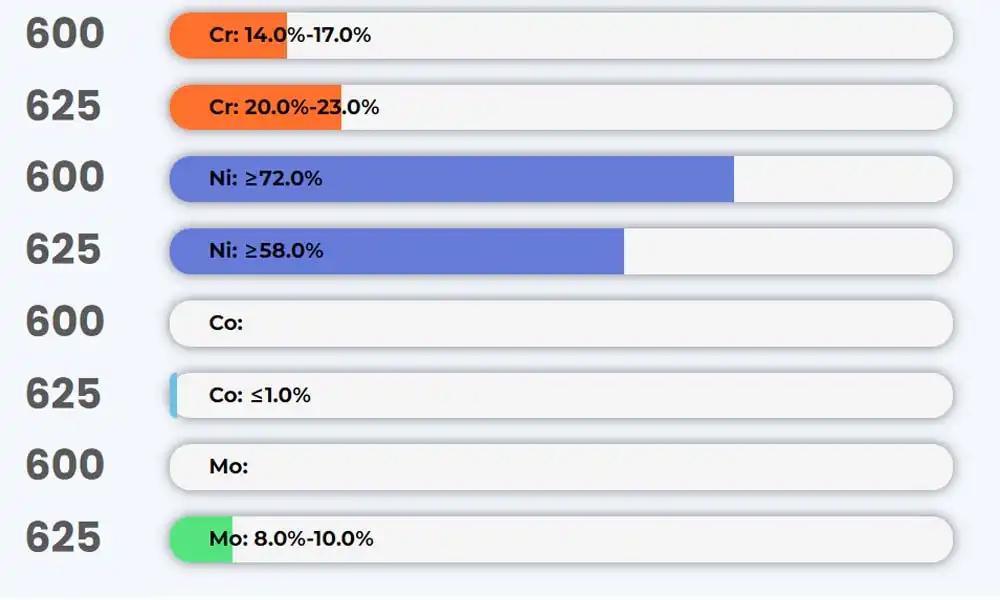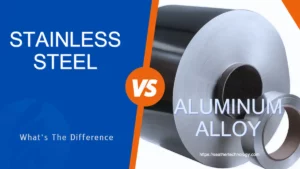Both alloy 600 and alloy 625 are solid solution strengthened Inconel alloys.
Due to some chemical composition differences, these two nickel-based alloys have different corrosion resistance and strength.
Within this blog article, we will thoroughly contrast these two alloys by delving into their chemical compositions, applications, and overall performance.
Let’s keep reading.
What is Alloy 600?
Grade alloy 600 is a standard engineering material for applications which require resistance to corrosion and heat.
The alloy also has excellent mechanical properties and presents the desirable combination of high strength and good workability.
What is Alloy 625?
Alloy 625 is a nickel-based super alloy that contains a high amount of nickel concentration, far more than any of its other grades. It has high strength and high resistivity even at extreme temperatures. It has been shown to be very resistant to corrosion and oxidation. These specific properties make it very useful in marine and nuclear environments.
The alloy 625 also referred to as the UNS N06625, W.Nr. 2.4856 refers to strong solution that has been strengthen by the presence on nickel making it have a high resistance to corrosion, great tensile strength, high oxidation and excellent fatigue properties.
Properties of this alloy 625 make it an excellent product for use in the manufacture of chemical equipment’s, aerospace structural parts, and aero-engine parts.
What are the Differences Between Alloy 600 and Alloy 625?
As you can see from their introduction and products types, alloy 600 and 625 are very different. Depending on what you are looking for in your project, they each have benefits and drawbacks. For a side by side comparison, you breakdown the differences even further.
Chemical Composition

Corrosion Resistance
Nickel alloys demonstrate impressive corrosion resistance due to the presence of nickel itself. This quality is effectively demonstrated in alloys like 600 and 625.
Alloy 625 boasts a higher proportion of chromium compared to Alloy 600. This chromium content is pivotal for the alloy’s resistance to oxidation. Consequently, 625 exhibits superior resistance to oxidation when compared to 600.
While Alloy 600 lacks molybdenum, Alloy 625 incorporates over 8% molybdenum, imparting a degree of resistance to reduction that is absent in Alloy 600.
In this comparison, it is evident that 625 excels in overall corrosion resistance.
Mechanical Properties
Alloy 600 Mechanical Properties
| Element | Density | Melting Point | Tensile Strength | Yield Strength (0.2%Offset) | Elongation |
| 600 | 8.47 g/cm3 | 1413 °C (2580 °F) | Psi – 95,000 , MPa – 655 | Psi – 45,000 , MPa – 310 | 40 % |
Alloy 625 Mechanical Properties
| Density | Melting Point | Tensile Strength | Yield Strength (0.2%Offset) | Elongation |
| 8.4 g/cm3 | 1350 °C (2460 °F) | Psi – 135,000 , MPa – 930 | Psi – 75,000 , MPa – 517 | 42.5 % |
Applications
Alloy 600 Applications
- Retorts
- Muffles
- Roller hearths
- Furnace components
- Heat-treating applications
Alloy 625 Applications
- Aerospace
- Chemical Processing
- Heat Exchangers
- Construction
- Bridges
- Petrochemical Industry
- Ship Building
- Engineering
- General Structural Purposes
Main Standards
Alloy 600 Products Standards
- Condenser and Heat Exchanger Tube: ASTM B163
- Seamless Pipe: ASTM B167, ASTM B829
- Welded Tube: ASTM B516, ASTM B751
- Welded Fittings: ASTM B366
- Round Rod&Bar: ASTM B166
- Forgings: ASTM B564
- Plate&Sheet, Strip&Foil: ASTM B168, ASTM B906
Alloy 625 Products Standards
- Seamless Pipe: ASTM B444, ASTM B829
- Welded Tube: ASTM B704, ASTM B751
- Welded Fittings: ASTM B366
- Round Rod&Bar: ASTM B446
- Forgings: ASTM B564
- Plate&Sheet, Strip and Foil: ASTM B443
Cost
Alloy 625 exhibits a greater level of alloying (with a more intricate composition), intricate processing requirements, and enhanced capabilities.
As a result, its cost surpasses that of 600 by a considerable margin.
If alloy 600 meets all the necessary criteria for your project, it is advisable to prioritize the selection of 600 to achieve cost savings.
FAQs
What is the density of alloy 600?
The alloy 600 has a density of 8.47 g/cm3, which makes it slightly heavier than other alloys such as copper alloy or aluminium alloy, but lighter than special stainless steel or titanium alloys.
Does Alloy600 rust?
Within the realm of nickel alloys, 600 stands out as a solid solution strengthened alloy comprised of constituents including nickel, chromium, and iron.
In particular, it does not show chloride corrosion cracking phenomenon that appears in the stainless steel.
Can Alloy 600 be welded?
Typically, there is no necessity for preheating when working with 600 for welding purposes.
However, if the temperature of the base metal falls below 15°C, it’s advisable to preheat the joint region on both sides, spanning 250 mm to 300 mm, to achieve a temperature of 15°C to 20°C. This preheating mitigates the risk of blow holes stemming from moisture condensation.
To prevent undesirable outcomes such as grain enlargement and carbide precipitation, it’s important to ensure that the inter-pass temperature doesn’t exceed 100°C.
It’s crucial to exercise caution against rapid cooling, which can lead to the formation of porosity. Thorough cleaning of the welding area before commencing the welding process is essential.
Given the limited molten flowability of nickel alloy, it’s recommended to have a sharp bevel end slope in the jointing area.
600’s welding pool is relatively shallow, potentially resulting in incomplete penetration. Optimal results are achieved with moderate welding current strength and a swift welding pace.
Considering 600’s high coefficient of linear thermal expansion and susceptibility to hot cracking, meticulous control over heat input during welding is paramount.
What is the density of 625?
Alloy 625 has a density of 8.44 g/cm3, which makes it slightly heavier than other alloys such as copper alloy or aluminium alloy, but lighter than special stainless steel or titanium alloys.
What is the difference between 625 alloy and 718 alloy?
625 possesses considerable amounts of nickel, chromium, and molybdenum making it not only strong at high temperatures but also resistant to corrosion, oxidation, and carburization. One of its most notable characteristics is its ability to prevent stress, pitting and crevice corrosion cracking even when exposed to chloride ions.
718 is an age-hardened version of alloy 625. Aging (or precipitation hardening) produces precipitates in the molecular structure that pins the grains of the metal in place. As a result, materials usually become significantly stronger. In the case of Inconel, 718 has exceptional strength with a yield strength that is about 2x’s stronger than 625.
Conclusion
Because of its elevated levels of chromium and molybdenum, the corrosion resistance of 625 alloy surpasses that of 600.
Owing to the synergistic impact of diverse strengthening components, alloy 625 demonstrates superior mechanical characteristics compared to alloy 600.
The consequence of heightened performance and a more intricate makeup is an increased cost, making the more economical alloy 600 the preferable choice when feasible.
At Seather, we manufacture cost-efficient products using both 600 and 625. If you require corresponding custom alloys solutions, please feel free to reach out to our expert team.






